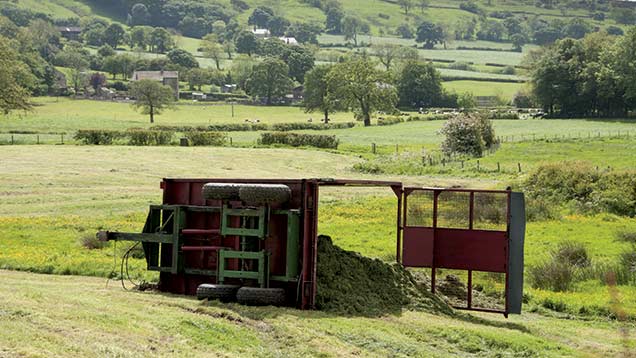Farm accidents: How to save a life in an emergency
 ©FLPA/Rex
©FLPA/Rex More than 430 people have been killed on farms over the past 10 years – 19 of them children under 16.
Falls from heights, crush injuries by livestock and machinery, slurry tanks and grain silo-related incidents, electrocution, burns and poisoning are all hazards.
Despite repeated campaigns to raise awareness of the risks, the latest Health and Safety Executive (HSE) figures show that that there were 29 fatal farm accidents last year.
Almost half (41%) of the workers who were fatally injured were farmers; another 17% were farmworkers and seven members of the public also suffered fatal injuries.
Share your farm safety tip to win a pair of Buckler Boots
Part of the solution is to persuade farmers to take safety more seriously and run fewer risks. Knowing what to do in an emergency is also important, and the Sandpiper Trust, a Scottish charity that provides emergency medical equipment for immediate care in remote and rural areas, has recently run several first aid courses for farmers.
Doctors, nurses and paramedics have set up realistic accident scenarios in barns and sheds then demonstrated what to do. Remember, a swift, calm and correct response could save a life.
Injuries you may be confronted with
External bleeding
Treat this by placing a clean absorbent material on the wound and apply firm pressure until the bleeding stops. Lift the wound above the victim’s heart if possible. This will minimise the flow of blood to the affected area.
Depending on the severity of the wound, call for the emergency services, or if it’s less severe take the person to the local emergency department. A tourniquet using whatever is to hand – a belt, bandage or scarf, for example – may be required in “last-resort” situations and should be tightly applied around the limb as close to the wound or amputation as possible.
Bike or quad crash
A biker should be assessed for signs of life. Call the emergency services then reassure the victim as they may be confused. Encourage them to stay still. If breathing is normal, leave the helmet on.
What to do in an emergency
1. Think safety Think of your own safety. Is it safe for you to approach and help? Look around for dangers, which might include moving vehicles, livestock, slippery surfaces, unstable roofing, dangerous toxic environments, a slurry pit, falling objects, hay bales or tree branches. Is it safe to go into the scene? Can you make it safe? If not, call out the emergency services. Do you need to move the victim(s) for their/your safety – perhaps because of the risk of fire, a collapsing building, or toxic gas build-up?
2. Get help Once you have assessed the scene and ensured your own safety and that of the victim, call for help. Dial 999 and inform the emergency services of your location, type of accident, any hazards at the scene, access issues to the location, number of casualties involved and the emergency services required – fire, police or ambulance.
3. Act quickly If it’s safe to approach, check the victim out, ask them “are you OK?” If they respond, begin to make an assessment of their problem and injuries. If they do not respond, assess rapidly the “ABCs”.
This should only be removed if the airway is blocked or the victim is not breathing. Check for signs of life every five minutes. If anything changes and breathing stops, remove the helmet and commence CPR as described right.
Drowning/asphyxiation in fluid
Ask yourself first: Is it safe to attempt a rescue? Can you get the victim out of the water or slurry safely? Call for emergency services.
Once removed from the fluid, place the victim on their back and open their airway.
Clear away any debris or materials from their mouth and nose. Assess if there are signs of normal breathing.
If they’re breathing, turn the patient on to their side, into the recovery position and continue to observe until emergency services arrive. If the victim is not breathing and there are no apparent signs of life, commence CPR.
The victim needs your rescue breaths first so give five breaths of air first, followed by 30 chest pumps. Continue with 30 pumps to two rescue breaths over and over until the emergency services arrive or the victim shows signs of life returning.
If possible use a mouth-to-mouth barrier if available to protect you from hazardous contact.
Fall from height
Ask first: Is it safe to approach the victim? If you suspect a back or neck injury, do not move the affected person (unless it is too dangerous
to leave them where they are).
Assume a person has a spinal injury if:
- There’s a head injury with a change in the person’s level of consciousness
- The person complains of severe pain in the neck or back
- The person won’t move their neck
- The person complains of weakness, numbness or paralysis or lack control of their limbs, bladder or bowels
- The neck or back is twisted or positioned oddly.
If you suspect someone has a spinal injury, call 999 for help, then:
- Keep the person still; place towels on both sides of the neck or head or hold the head and neck to prevent movement
- Provide as much first aid as possible without moving the person’s head or neck
- If the person has no pulse, begin chest pumps
- Only if a person is vomiting or choking on blood or in danger of further injury should they be moved.
Burns
Call for help immediately.
For first-degree burns (redness, mild swelling, pain), immerse in cold water, and apply layers of clingfilm squares. Do not apply butter or margarine.
For second-degree burns (deeper, blisters developing), immerse in cold water for at least 10 minutes and apply clean/sterile dressing/clingfilm squares.
For third-degree burns (deep destruction, skin layers destroyed), cover with a clean/sterile cloth to protect. Treat for shock, watch for breathing difficulty and obtain medical attention rapidly. Do not remove clothing that is stuck to the burn.
Poisoning
Immediately remove the hazardous material from the vicinity, if it’s safe to do so. Dial 999.
If the poison is a solid, such as plant material or pills taken as in intentional overdose, remove it from the mouth.
If the poisoning is a gas, take the person out of the affected area. If the poison is corrosive to the skin, such as insecticide, remove the victim’s clothing without getting material on yourself. Flush the affected area with copious amounts of water for at least 15 minutes then wash the area with soap and water.
Do not induce vomiting. You may offer ice if available to soothe burning lips but give nothing to drink.
Remember your ABCs…
A – Airway
Open the patient’s airway by lifting their chin upwards. Try not to move them unless absolutely necessary. If there’s anything in their mouth – such as slurry, plants, food – remove it if possible.
B – Breathing
With the airway open, the victim should be breathing. If they are not breathing normally, roll them on to their back and start CPR. CPR should be started and continued uninterrupted until the emergency services reach you.
C – CPR
To perform cardiopulmonary resuscitation (CPR), place your hands on top of each other in the centre of the victim’s chest and start rhythmically pumping up and down at approximately two pumps/ second.
After 30 pumps, tilt the head back, hold the victim’s nose closed and give two rescue breaths (the “kiss of life”).
Keep repeating 30 pumps followed by two rescue breaths until the emergency services arrive on the scene.


